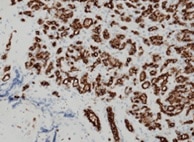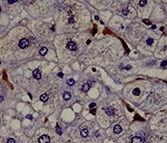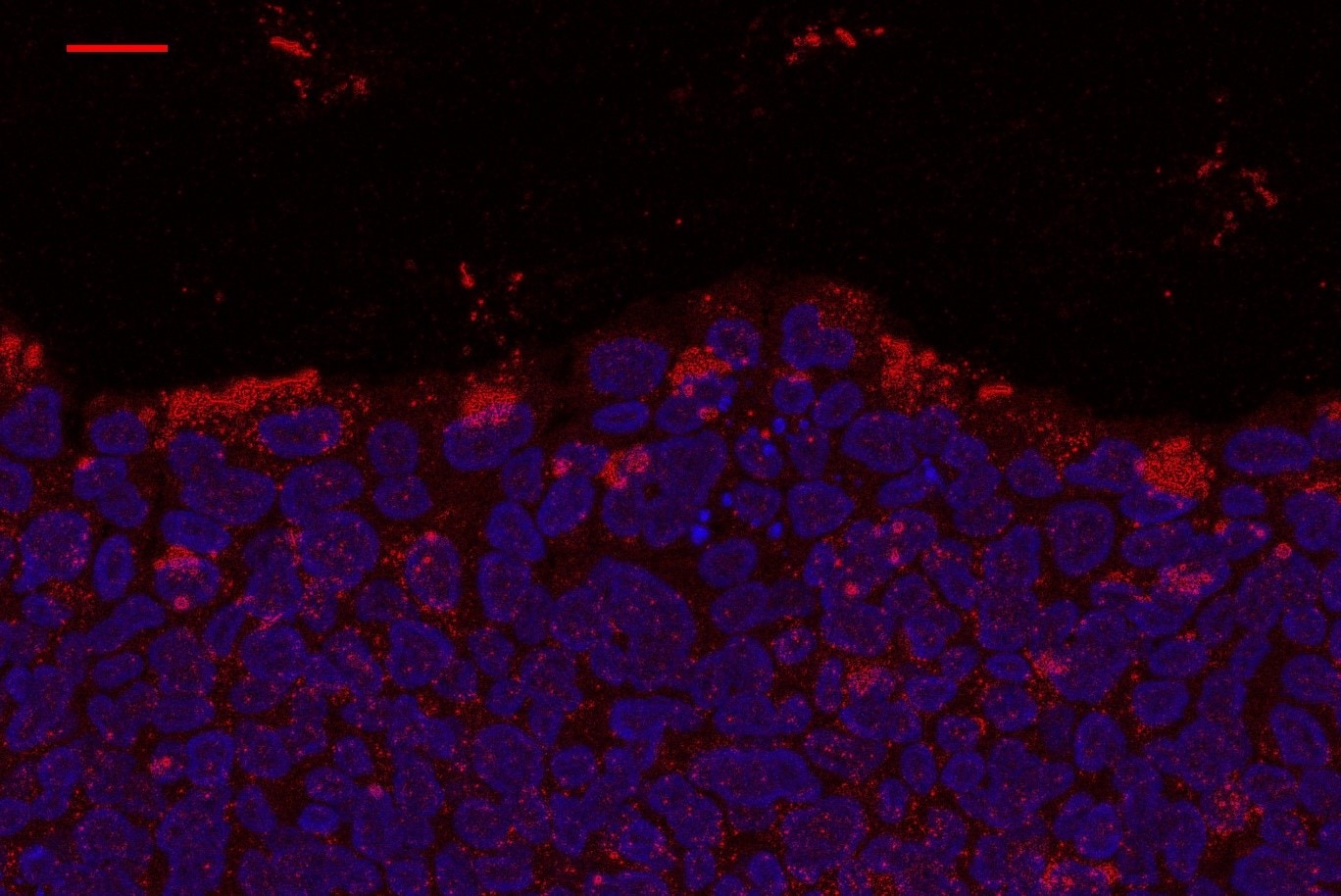Human/Mouse DLL4 Antibody Summary
Ser28-Pro525
Accession # Q9JI71
Applications
Please Note: Optimal dilutions should be determined by each laboratory for each application. General Protocols are available in the Technical Information section on our website.
Scientific Data
 View Larger
View Larger
DLL4 in Mouse Embryonic Heart. DLL4 was detected in immersion fixed frozen sections of mouse embryonic heart using Rat Anti-Human/Mouse DLL4 Monoclonal Antibody (Catalog # MAB1389) at 8 µg/mL overnight at 4 °C. Tissue was stained using the Anti-Rat HRP-DAB Cell & Tissue Staining Kit (brown; Catalog # CTS017) and counterstained with hematoxylin (blue). Specific staining was localized to developing cardiomyocytes. View our protocol for Chromogenic IHC Staining of Frozen Tissue Sections.
Preparation and Storage
- 12 months from date of receipt, -20 to -70 °C as supplied.
- 1 month, 2 to 8 °C under sterile conditions after reconstitution.
- 6 months, -20 to -70 °C under sterile conditions after reconstitution.
Background: DLL4
Delta-like protein 4 (DLL4) is a type I membrane protein belonging to the Delta/Serrate/Lag2 (DSL) family of Notch ligands (1). Notch signaling is an evolutionarily conserved pathway that controls cell fate and is required in multiple developmental processes including vascular development, hematopoiesis, somatogenesis, myogenesis, and neurogenesis (2-4). Dysregulation in the Notch pathway is associated with various human diseases. In mammals, four Notch homologs (Notch 1 to 4) and five ligands (DLL 1, 3 and 4, Jagged 1 and 2) have been identified. Notch ligands are transmembrane proteins with a DSL motif necessary for Notch binding, tandem EGF repeats, a transmembrane region and a short intracellular domain (ICD). Notch ligands are categorized into two subfamilies based on the presence of an extracellular cysteine-rich domain and insertions that interrupt some EGF repeats in the Jagged but not the Delta ligand family. Interactions of Notch receptors with their ligands results in reciprocal regulated intramembrane proteolysis (RIP) (4). RIP is a mechanism for transmembrane signal transduction that involves the sequential processing by a disintegrin metalloprotease (ADAM) and then by presenilin/ gamma secretase, resulting in shedding of the extracellular domains and the generation of the soluble ICD signaling fragments, respectively. The Notch ICD translocates to the nucleus and interacts with transcriptional coactivators, resulting in the transcription of target genes. The ICDs of the Notch ligands have also been shown to translocate to the nucleus where they may have a signaling function (5, 6). DLL4 is expressed highly and selectively within the arterial endothelium and has been shown to function as a ligand for Notch 1 and Notch 4. Human and mouse DLL4 share 86% amino acid sequence identity (1).
- Shutter, J.R. et al. (2000) Genes Dev. 14:1313.
- Iso, T. et al. (2002) Arterioscler. Thromb. Vasc. Biol. 23:543.
- Walker, L. et al. (2001) Stem Cells 19:543.
- Baron, M. (2002) Semin. Cell Dev. Biol. 14:113.
- Ikeuchi, T. and S.S. Sisodia (2003) J. Biol. Chem. 278:7751.
- Bland, C.E. et al. (2003) J. Biol. Chem. 278:13607.
Product Datasheets
Citations for Human/Mouse DLL4 Antibody
R&D Systems personnel manually curate a database that contains references using R&D Systems products. The data collected includes not only links to publications in PubMed, but also provides information about sample types, species, and experimental conditions.
10
Citations: Showing 1 - 10
Filter your results:
Filter by:
-
CCN1 interlinks integrin and Hippo pathway to autoregulate tip cell activity
Authors: Park MH, Kim AK, Manandhar S et al.
Elife
-
Anti-DLL4 VNAR targeted nanoparticles for targeting of both tumour and tumour associated vasculature
Authors: Adam Leach, Peter Smyth, Laura Ferguson, John Steven, Michelle K. Greene, Cristina M. Branco et al.
Nanoscale
-
Atypical chemokine receptor ACKR3/CXCR7 controls postnatal vasculogenesis and arterial specification by mesenchymal stem cells via Notch signaling
Authors: ST Wei, YC Huang, ML Hsieh, YJ Lin, WC Shyu, HC Chen, CH Hsieh
Cell Death Dis, 2020-05-04;11(5):307.
Species: Human
Sample Types: Cell Culture Supernatents
Applications: Western Blot -
Muscle Satellite Cell Cross-Talk with a Vascular Niche Maintains Quiescence via VEGF and Notch Signaling
Authors: M Verma, Y Asakura, BSR Murakonda, T Pengo, C Latroche, B Chazaud, LK McLoon, A Asakura
Cell Stem Cell, 2018-10-04;23(4):530-543.e9.
-
MEF2 transcription factors are key regulators of sprouting angiogenesis
Authors: Sarah De Val
Genes Dev., 2016-10-15;30(20):2297-2309.
Species: Mouse
Sample Types: Whole Tissue
Applications: IHC -
Suppression of ischemia in arterial occlusive disease by JNK-promoted native collateral artery development
Elife, 2016-08-09;5(0):.
Species: Mouse
Sample Types: Cell Lysates, Whole Cells
Applications: IHC-Fr, Western Blot -
Quantitative assessment of angiogenesis, perfused blood vessels and endothelial tip cells in the postnatal mouse brain.
Authors: Walchli T, Mateos J, Weinman O, Babic D, Regli L, Hoerstrup S, Gerhardt H, Schwab M, Vogel J
Nat Protoc, 2014-12-11;10(1):53-74.
Species: Mouse
Sample Types: Whole Tissue
Applications: IHC -
The alarmin IL-33 is a notch target in quiescent endothelial cells.
Authors: Sundlisaeter E, Edelmann R, Hol J, Sponheim J, Kuchler A, Weiss M, Udalova I, Midwood K, Kasprzycka M, Haraldsen G
Am J Pathol, 2012-07-16;181(3):1099-111.
Species: Human
Sample Types: Whole Cells
Applications: ICC -
KSHV-induced notch components render endothelial and mural cell characteristics and cell survival.
Authors: Liu R, Li X, Tulpule A, Zhou Y, Scehnet JS, Zhang S, Lee JS, Chaudhary PM, Jung J, Gill PS
Blood, 2009-11-24;115(4):887-95.
Species: Human
Sample Types: Cell Lysates
Applications: Western Blot -
CD8- DCs induce IL-12-independent Th1 differentiation through Delta 4 Notch-like ligand in response to bacterial LPS.
Authors: Skokos D, Nussenzweig MC
J. Exp. Med., 2007-06-18;204(7):1525-31.
Species: Mouse
Sample Types: Cell Lysates
Applications: Western Blot
FAQs
No product specific FAQs exist for this product, however you may
View all Antibody FAQsReviews for Human/Mouse DLL4 Antibody
Average Rating: 4.3 (Based on 3 Reviews)
Have you used Human/Mouse DLL4 Antibody?
Submit a review and receive an Amazon gift card.
$25/€18/£15/$25CAN/¥75 Yuan/¥2500 Yen for a review with an image
$10/€7/£6/$10 CAD/¥70 Yuan/¥1110 Yen for a review without an image
Filter by:




